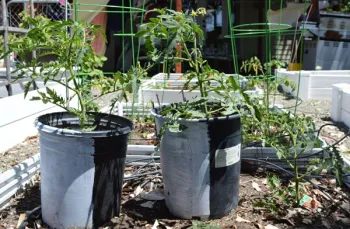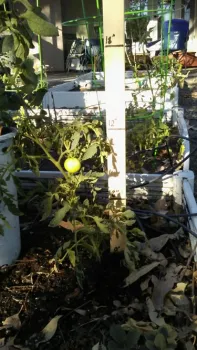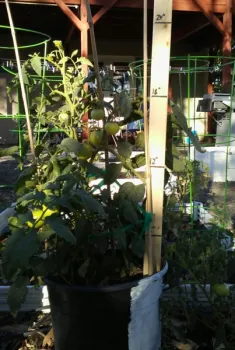To document this I purchased tomatoes plants (Ace variety, from a 4 pack), and utilized three of the plants to run a trial to see if I could determine how significantly the eucalyptus roots affected the tomato plants' growth.
First, I planted one tomato plant directly into the root-infested raised bed. The second tomato plant was planted in a 5-gallon container which I filled using the raised bed root materials, cut up into chunks, and planted the tomato directly into this mixture. This planting was to test to see if the dead Eucalyptus roots had any phytotoxic effects on the tomatoes. The third tomato was essentially my control, with the tomato planted in a 5-gallon container in the new potting mix. All were fertilized bi-weekly with low nitrogen organic fertilizer and watered every other day.
The experiment was run for about 5 weeks. I found that the tomato planted directly into the root-infested raised bed grew very little, and seemed to struggle to get enough water, so I gave it extra water. The tomato planted in the chopped Eucalyptus roots with the raised bed potting mix actually did quite well and has the best set of tomatoes. There does not seem to be any phytotoxic effects from the dead Eucalyptus roots. The tomato in the new potting mix is growing fine and has set some tomatoes but fewer than the tomato plant in the dead roots. My belief is that this might be due to more nitrogen in the fresh potting mix.
Other garden vegetables such as vine crops, beans, and some other plants do not tolerate the root competition. We have found that carrots do okay, asparagus does moderately well, and potatoes are marginal. However, all these crops grow during the spring months when there is more free water in the soil.
The Australian Department of Agriculture and Water Resources recommends that farmers stay 50 feet away from Eucalyptus, we are within 30 feet. We have shifted to above ground containers after excavating several raised beds and lining them with double landscape fabric to no avail.
Four photos are attached separately, as well:
Photo 1: Initial photo of the three tomato plants





